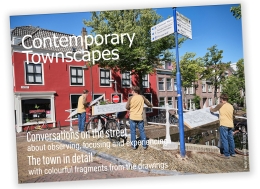
Street drawing
My pen townscapes appeal to a wide section of the public. They are colourful, instantly recognizable and feature a wealth of detail, so there is always something new to discover.
I have already recorded special locations in Delft, Amsterdam, Haarlem, The Hague and Nijmegen.

foto: Robert van Nimwegen
Townscapes
On this site you will find more than 20 different townscapes featuring famous Dutch towns. You can order the townscapes online, or make an appointment to visit my studio to view my work before purchase.
This page shows you how a townscape is created.

INTERESTED IN THE BROCHURE?
Take a closer look at the colourful details of my townscapes in this digital brochure. Just drop me an email and I’ll be glad to send it to you. Please mention whether you’d prefer the Dutch or English version: aW5mb0BodXlzdGVlLmNvbQ==
BICYCLES AT THE ARCHIVES
Acquisition by the archives of municipality Delft.
Delf, Cultural heritage magazine for Delft. Year 16 nr. 3, fall 2014.
By Annika Hendriksen, curator Image and Sound by the Delft Archives.

WATCHING AND DAYDREAMING
Blauww, Magazine about culture, knowledge, entrepreneurship and lifestyle.
Year 2 nr. 7 | April 2017
'Watching and daydreaming' by Anita Boone.
Click here for the article in English.
 photo: Robert van Nimwegen
photo: Robert van Nimwegen
PERSONAL MEMORIES
Street drawing is more than just making a pretty picture. Each of us has their own special memories of a special location in a town. Every day Robert hurried to his work in the market square, where Cecilia lived in student digs at number 8. Street drawing always brings out the reminiscences of bystanders.
For anyone familiar with the location, a completed townscape acts like a backdrop for personal memories and experiences.

Each townscape is like a trip down Memory Lane to a place of personal significance.
 photo: Marcel van Huystee
photo: Marcel van Huystee
SEEMINGLY INSIGNIFICANT DETAILS
This is how I build up a townscape. I start by drawing a seemingly insignificant detail. It could be a waste disposal bin, a cigarette butt, or some bicycle handlebars. That will be the basis from which I gradually build up the rest of the townscape. Every detail receives the some level of attention. I do not build up a perspective, nor do I make any preliminary sketches: every line is final and nothing is changed.
This results in a townscape that is a combination of details and moments that together will form a plausible scene.
interactions
Of course, there’s no way you can sit out in the street with a large drawing board and not get interrupted. Drawing in public places inevitably elicits a response from passers-by.
I like that because it enables me to get a feel for the people as well as the surroundings. After all, they’re both in the picture.
Most remarks from passers-by are easier to translate into text than into images. Writer Jan van der Mast drops by on a regular basis and writes columns about the people that pass the drawing location, bringing the spot even more alive.
CRIKEY! BY JAN VAN DER MAST
Mark is drawing a townscape near the Old Church in Delft. It looks impressive. A tanned old man with short sleeves is standing behind Mark. With a hoarse, Don Corleone type of voice he says: “That’s really detailed, that is. That’s full of detail. I couldn’t do that, I’m too fidgety. I do a bit of drawing too. By way of a hobby.” His wife joins us. “Our entire house is decorated with his drawings. There’s not an empty spot left.” “Perhaps you could continue on the ceiling?” Mark suggests, always willing to think along. “No, that wouldn’t do; we’ve got wallpaper there.” “On the ceiling?” “Yes, when we bought the house the ceiling was in a very bad state, and we thought we’d cover it with wallpaper, like they do in Germany. The first length was pretty hard going. It came down immediately. Then my husband stretched some wires, and that worked very well. It’s turned out very nice indeed.” The husband picks up his drawing thread again: “I do windmills. Marvellous things. I never get them right on the paper, though. I’m far too finicky.” “Mark’s not like that at all,” I reply. “Just look at the house front he’s drawing now. It doesn’t match the real thing at all. Not that anybody cares. There is enough to see.” “It’s not finished yet,” Mark says, completing the stepped gable with a few quick strokes. The old couple say their fond farewells and then they leave.
Jan van der Mast, Thursday, 2 July 2009
“No, that wouldn’t do; we’ve got wallpaper there.”
“On the ceiling?”
COLOURING
Each panorama takes me something between 40 and 60 hours to draw. The finished drawing is scanned and loaded as a computer image, where I add the colours. Doing the colours is a very time-consuming job, and taking 80 hours to do the colours of a single townscape is no exception.

PRINTING
Once the work has been coloured, a series of proofs is printed. If these pass muster, a limited print run is started. The editions are of high quality and meet the ‘Certified Art Giclée’ quality standard.
FInally, each print is numbered and signed by me.
You will find over 20 different townscapes for sale in my web shop.
embossed signature
Since 2012, each print is embossed with my signature.
Each print comes with its own Certificate of Authenticity

SHOWINGS
I like to put each townscape on show at or near the drawing location, since that is where most passers-by will recognise the location and the memories that the drawing evokes.


One on your wall







